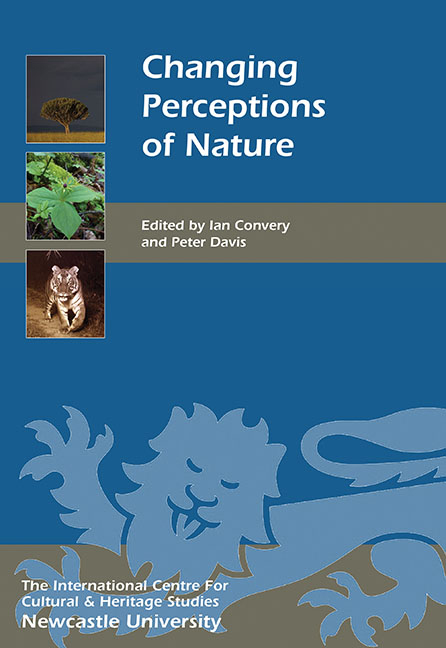Book contents
- Frontmatter
- Contents
- List of Illustrations
- Acknowledgments
- List of Abbreviations
- Foreword
- Introduction
- HISTORICAL PERSPECTIVES ON NATURE
- COLLECTING NATURE
- INTERPRETING NATURE AND LANDSCAPES
- CONSERVING NATURE
- 18 The Public Perception of Protected Areas in the UK
- 19 Conservation of Rare Species and Natural Heritage: the Wild and the Tame
- 20 Our Vanishing Natural Heritage and The Wildlife Trusts: a Century of Influence and Local Action for Nature and People
- 21 A Champion of the Tiger's Cause
- PEOPLE–NATURE INTERACTIONS
- List of Contributors
- Index
- Miscellaneous Endmatter
18 - The Public Perception of Protected Areas in the UK
from CONSERVING NATURE
Published online by Cambridge University Press: 26 October 2017
- Frontmatter
- Contents
- List of Illustrations
- Acknowledgments
- List of Abbreviations
- Foreword
- Introduction
- HISTORICAL PERSPECTIVES ON NATURE
- COLLECTING NATURE
- INTERPRETING NATURE AND LANDSCAPES
- CONSERVING NATURE
- 18 The Public Perception of Protected Areas in the UK
- 19 Conservation of Rare Species and Natural Heritage: the Wild and the Tame
- 20 Our Vanishing Natural Heritage and The Wildlife Trusts: a Century of Influence and Local Action for Nature and People
- 21 A Champion of the Tiger's Cause
- PEOPLE–NATURE INTERACTIONS
- List of Contributors
- Index
- Miscellaneous Endmatter
Summary
With respect to landscape, it has been suggested by Appleton (1975) that throughout the 200,000 or so years of our species’ existence, humans have felt emotionally comfortable in environments which offer ‘prospect and refuge’ – that is, a suitable vantage-point and concealment from predators and enemies. For the most part of human existence we have been hunter-gatherers and, according to Appleton, we remain genetically hard-wired to favour the idyllic pastoral landscapes, featuring both cover and openness, which by the seventeenth century were being painted by artists such as Claude Lorrain.
In contrast, reasons for valuing nature, at least in Britain, have evolved. Lowe (1983) recognised four phases. There was firstly a ‘natural history–humanitarian’ period in the nineteenth century, when nature was studied for its own sake and incorporated a reaction against cruelty and the slaughter of birds for sport. Following, but overlapping with this phase, and informed by a growing recognition of the vulnerability of nature, was the ‘preservationist’ period, lasting until World War II and exemplified by Charles Rothschild's founding of the Society for the Promotion of Nature Reserves in 1912 – effectively the beginning of modern nature conservation in Britain. Overlapping and following again came the ‘scientific’ period, with the flourishing of ecology as a scientific discipline, its application in nature reserve management and in the use of nature reserves for research. It was expressed from 1949 in the Nature Conservancy, the beginning of State involvement in nature conservation in the UK. This occurred alongside State involvement in landscape conservation and access to the countryside, following the passage of the 1949 National Parks and Access to the Countryside Act. More recently Lowe identifies a ‘popular-political’ period, when threats to the environment were brought sharply into focus by well-publicised disasters such as sea bird wrecks, and widely read polemics such as Rachel Carson's Silent Spring (Carson 1962). At the same time the media, especially television (eg BBC Wildlife Unit), began exploring the potential of natural history, including commentary on a range of environmental issues.
One might perhaps add to Lowe's phases a recent ‘biodiversity planning’ period, originating in the Rio Convention on Biodiversity, deriving from the Earth Summit of 1992.
- Type
- Chapter
- Information
- Changing Perceptions of Nature , pp. 185 - 194Publisher: Boydell & BrewerPrint publication year: 2016



